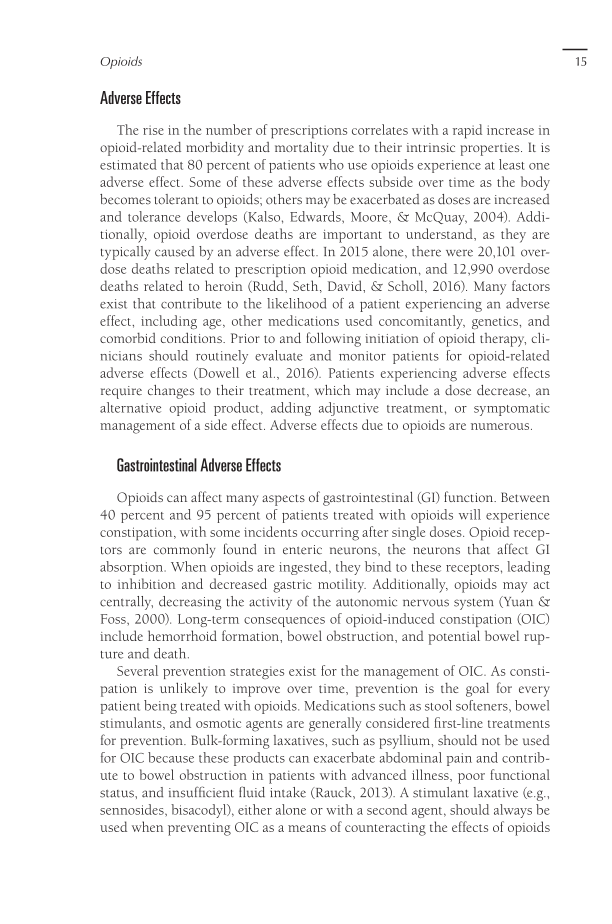Opioids 15 Adverse Effects The rise in the number of prescriptions correlates with a rapid increase in opioid-related morbidity and mortality due to their intrinsic properties. It is estimated that 80 percent of patients who use opioids experience at least one adverse effect. Some of these adverse effects subside over time as the body becomes tolerant to opioids others may be exacerbated as doses are increased and tolerance develops (Kalso, Edwards, Moore, & McQuay, 2004). Addi- tionally, opioid overdose deaths are important to understand, as they are typically caused by an adverse effect. In 2015 alone, there were 20,101 over- dose deaths related to prescription opioid medication, and 12,990 overdose deaths related to heroin (Rudd, Seth, David, & Scholl, 2016). Many factors exist that contribute to the likelihood of a patient experiencing an adverse effect, including age, other medications used concomitantly, genetics, and comorbid conditions. Prior to and following initiation of opioid therapy, cli- nicians should routinely evaluate and monitor patients for opioid-related adverse effects (Dowell et al., 2016). Patients experiencing adverse effects require changes to their treatment, which may include a dose decrease, an alternative opioid product, adding adjunctive treatment, or symptomatic management of a side effect. Adverse effects due to opioids are numerous. Gastrointestinal Adverse Effects Opioids can affect many aspects of gastrointestinal (GI) function. Between 40 percent and 95 percent of patients treated with opioids will experience constipation, with some incidents occurring after single doses. Opioid recep- tors are commonly found in enteric neurons, the neurons that affect GI absorption. When opioids are ingested, they bind to these receptors, leading to inhibition and decreased gastric motility. Additionally, opioids may act centrally, decreasing the activity of the autonomic nervous system (Yuan & Foss, 2000). Long-term consequences of opioid-induced constipation (OIC) include hemorrhoid formation, bowel obstruction, and potential bowel rup- ture and death. Several prevention strategies exist for the management of OIC. As consti- pation is unlikely to improve over time, prevention is the goal for every patient being treated with opioids. Medications such as stool softeners, bowel stimulants, and osmotic agents are generally considered first-line treatments for prevention. Bulk-forming laxatives, such as psyllium, should not be used for OIC because these products can exacerbate abdominal pain and contrib- ute to bowel obstruction in patients with advanced illness, poor functional status, and insufficient fluid intake (Rauck, 2013). A stimulant laxative (e.g., sennosides, bisacodyl), either alone or with a second agent, should always be used when preventing OIC as a means of counteracting the effects of opioids
Document Details My Account Print multiple pages
Print
You have printed 0 times in the last 24 hours.
Your print count will reset on at .
You may print 0 more time(s) before then.
You may print a maximum of 0 pages at a time.











































































































































































































































































































































